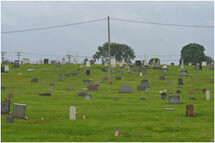
Church-owned cemetery's restoration celebrated
 BY JOHN W. COLEMAN
BY JOHN W. COLEMAN
Baltimore’s historic City of the Dead for Colored People is slowly coming back to life. First known by that name, Mount Auburn Cemetery, established by Sharp Street Memorial United Methodist Church in 1872, is enjoying a renaissance, thanks to a constellation of helpful partners who recently celebrated its ongoing restoration.
Created to entomb African Americans banned from segregated white cemeteries, the burial place with more than 50,000 graves holds many well-known and beloved figures, including civic leaders, entertainers, athletes, educators, soldiers, clergy and even a few bishops. But over decades the aging necropolis, listed on the National Register of Historic Places as one of the nation’s oldest African American burial grounds, fell victim to neglect. Occasional clean-up efforts could not overcome the rampant sticker bushes and weeds, mounting debris, fallen tombstones, hidden graves and occasionally exposed remains.
Unable to afford or provide the constant maintenance needed due to its own declining fortunes, Sharp Street Memorial Church appealed for help. That help came from several directions, and today the equally historic, 215-year old church has restored pride in a property that had long been a source of public scorn and embarrassment.
About 50 people—including church and community leaders, political officials, news reporters and other supporters—toured the grounds after gathering for a solemn but joyous rededication ceremony and ribbon-cutting on a rainy Monday morning, May 14. They witnessed a new stone wall, wrought-iron fence and arching sign encompassing the verdant 34 acres dotted with marble monuments and headstones.
 Maryland Gov. Martin O’Malley offered poetry and prose in naming revered heroes interred beneath Mount Auburn’s sacred ground and noted the “many untold stories of black soldiers and citizens who took part in the defense of Baltimore.”
Maryland Gov. Martin O’Malley offered poetry and prose in naming revered heroes interred beneath Mount Auburn’s sacred ground and noted the “many untold stories of black soldiers and citizens who took part in the defense of Baltimore.”
He recalled first seeing the cemetery on a neighborhood tour when he was Baltimore’s mayor and not recognizing it from the overgrowth of bushes and weeds. Stopping by recently to see the progress made, he recalled, “My eyes filled with tears of joy, and I felt like thousands of ancestors were applauding what you have been able to do to recover this place.”
O’Malley joined Baltimore Mayor Stephanie Rawlings-Blake, Bishop John Schol and other state, city and United Methodist leaders in signifying the remarkable restoration progress made so far. Along with Sharp Street Church, the Baltimore-Washington Conference, Morgan State University, the surrounding community and other benefactors, the governor lauded one other unlikely group of crucial contributors to the restoration progress: prison inmates.
Since 2008 the state Department of Corrections’ innovative Public Safety Works program has employed dozens of inmates to work on the cemetery grounds. The opportunity to learn skills and earn minimal income reportedly helps prepare them for reentry into society and reduces the likelihood of their return to incarceration.
Working at Mount Auburn also teaches inmates a lot about Baltimore’s black history, said department head Gary Maynard, and endears them to both community neighbors and to Sharp Street. Each November inmates worship and fellowship with the congregation to celebrate Mount Auburn Cemetery Day. Several were present at the rededication event.
The Rev. Douglas Sands, a retired United Methodist pastor and former chair of the Mt. Auburn board of directors, recounted the cemetery’s early history, noting its important legacy and “the commendable efforts made to rise to a level of accountability that this cemetery deserves.”
Bishop John Schol, before offering a benediction, recalled working with other conference clergy and laity on the cemetery’s restoration. Teams of volunteers, especially members of United Methodist Men armed with landscaping tools, have spent Saturdays cutting down tangled vines, bushes and weeds, leveling tree stumps, clearing trash from the grounds and righting tilted headstones.
“I’m a person of faith,” said Sherman Harris, who helped lead many of those efforts and also photographed the celebration, “but I didn’t think I’d ever see it in this present state.”
The Rev. Dellyne Hinton began making connections needed for the cemetery’s restoration when she arrived as Sharp Street’s first female pastor in 2004. While working behind the scenes, she asked her father, Rev. Sands, to chair the board and leverage his influence with Baltimore’s Morgan State University, where he once served as campus minister, and among other potential partners.
Morgan State, founded as the Centenary Bible Institute in the basement of Sharp Street Church in 1867, is helping the board develop a long-range master plan, including landscape architectural designs, to sustain and develop Mount Auburn. Faculty and students have also been helping to restore the cemetery’s many fragile, handwritten burial records.
“Morgan State has done a lot of work utilizing what we had,” said Hinton. “At first we didn’t try to solicit financial support from anyone. Our goal was to establish a solid foundation and accountability that people could trust. After so many starts and stops, we wanted to show a good-faith effort and develop a master plan that people could build on.”
Along with about $2,000 donated by United Methodists as an Advance Special, Mt. Auburn received a $90,000 grant from Baltimore’s Abell Foundation to fund the prison inmates’ work, but it ends in December. So the search is on for more grants, including funds needed to help the board digitize burial records and improve their preservation and availability to the public.
“We have much more to do, but this moment represents the coming together of many pieces to the puzzle,” said Hinton, who leaves Sharp Street in July to become pastor of Gwynn Oak United Methodist Church in Baltimore. “I am excited and proud—we all are—to see how much God is doing to make this place like new. No one believed we could do it. This is all from God’s grace.”

Login/Register to leave comment